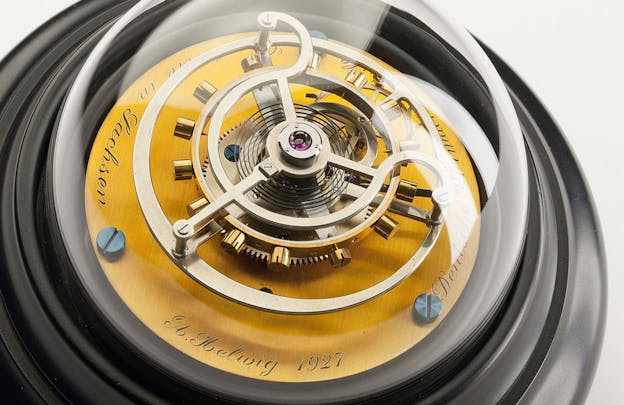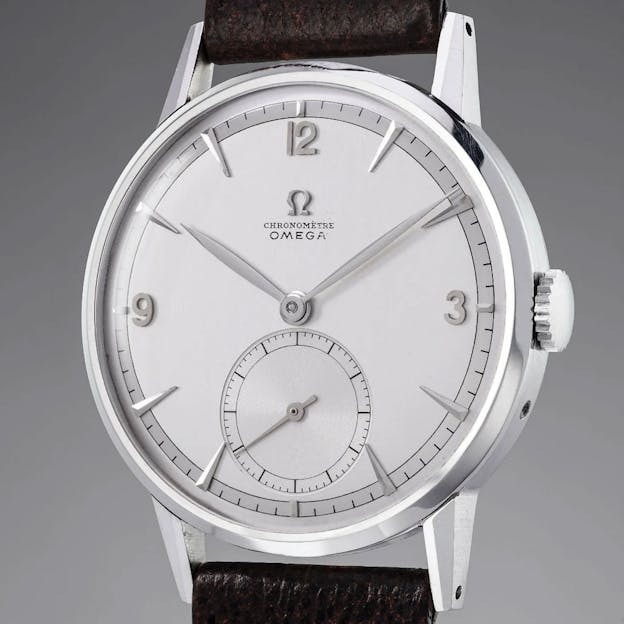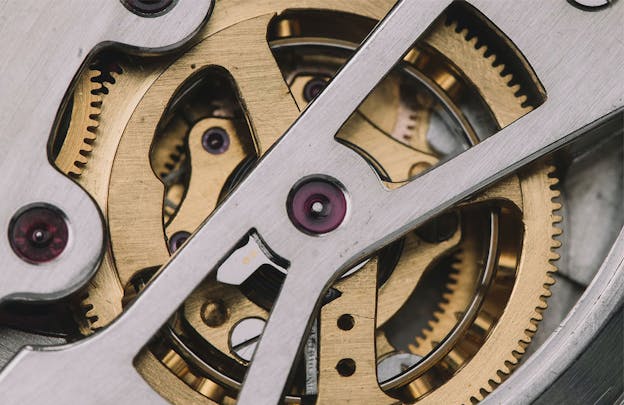Tourbillon Chronicles Part II: Two Centuries Of Evolution
How the tourbillon earned its reputation as one of the pinnacles of watchmaking.
During his lifetime, Breguet produced only a small number of tourbillons — according to Montres Breguet SA, 35 were known to have been made and only 10 or so are known to have survived. The reason for the relative rarity of the tourbillon in Breguet’s output is easy to understand once you realize that despite the ubiquity of the tourbillon today in the output of most fine watchmaking brands, it was for much of its history, extremely difficult to make.
A tourbillon offers at least the hope of technical improvements over a non-tourbillon watch — Breguet, based on his existing correspondence, notes, and patent, thought that the tourbillon could help correct errors in poise in the balance, aid in even distribution of lubricants (oils in his day were by modern standards, extremely primitive — animal and vegetable fats were used in watchmaking and such oils oxidize and break down rapidly compared to high performance modern synthetic watchmaking oils) and also reduce the effect of variations in rate in different positions.
However, the tourbillon presents a number of serious technical obstacles as well. The single biggest problem with the tourbillon is that it adds a considerable amount of inertia to the going train, and moreover, adds it right where you want inertia to be as low as possible: at the escapement. In a conventional watch, the escape wheel advances one tooth every time the balance unlocks the lever, and the balance is kept moving by the energy kicked back to the balance by the push on the lever given by the escape wheel. The only forces the going train has to overcome are the inertia of the balance and escape wheel (the smallest and lightest gear by far in the going train) and the energy lost to the escape wheel through the lever itself (as well as the energy needed to unlock the lever, and the almost negligible frictional losses at the escape wheel, lever, and balance pivots).

With a tourbillon, however, the amount of inertia increases dramatically. Every time the escapement unlocks, the going train has to overcome the inertia of the tourbillon cage, plus all the components that rotate along with it — the balance, spring, lever (if the watch uses a lever escapement) and escape wheel all have to move forward until the escapement locks again; how many times per second this happens depends on the frequency of the balance. The lower the rotational speed of the balance, the less inertia there is to overcome as the angular distance is less (Breguet often used four minute tourbillons although today most tourbillon wristwatches rotate once per minute) but there is no getting around the fact that no matter what, there is a lot more inertia the movement has to fight against in a tourbillon, than in a conventional watch.
The promise of greater precision seemed to some masters of watchmaking to make the game worth the candle. However, the tourbillon was out of reach of any but the most skilled horologists. In order for it to work, the amount of energy reaching the escapement needed to be optimized as much as possible and the losses due to friction and inertia through the going train, tourbillon cage, and regulating components had to be made as small as possible.

This meant that every component in the going train had to be made to the highest standard — gear teeth had to be perfectly formed and polished, pivots had to be perfectly burnished, and at the tourbillon itself, the carriage had to be constructed so as to be as light as possible. A look at tourbillon carriages in pocket watch tourbillons made by various masters in the two or so centuries after Breguet’s patent in 1801, generally show gossamer-thin enclosures, and the cage itself, like the balance and spring, had to be carefully poised so as to avoid introducing additional poise errors in the act of trying to minimize them.
Before going any further, it is worth pointing out that while Breguet certainly held the first patent for a tourbillon, as well as being indisputably the first watchmaker to construct a tourbillon, that there is reason to believe that the idea may have arisen elsewhere. Breguet’s close friend, the English watchmaker John Arnold, is thought in some quarters to have come up with the idea. The thought is that while Arnold may have originally conceived the tourbillon, he died (in 1799) before being able to actually construct one.

To support this idea, there is the fact that one of the two earliest known tourbillons (Breguet No. 169) was built, by Breguet, into a chronometer movement originally made by Arnold in 1774. The movement of No.169 also carries a plate engraved, “1er REGULATEUR A TOURBILLON DE BREGUET RÉUNI A UN DES PREMIERS OUVRAGES D’ARNOLD. HOMMAGE DE BREGUET, A LA MÉMOIRE RÉVÉRÉE D’ARNOLD, OFFERT A SON FILS AN 1808.” The tourbillon in No. 169 was obviously constructed some time before its presentation to Arnold’s son in 1808 but it’s not known exactly when. The other of the first two tourbillons was No. 282, but in The Art Of Breguet, George Daniels says that in his view, 282 was a prototype never meant to be sold and in fact, it was not cased and sold (by Breguet’s son) until 1832. (Montres Breguet SA says that No. 282 was completed in 1800).
That No.169 bears a dedication to Arnold is certainly highly suggestive, as is a paragraph in Treatise On Watch And Clockmaking, by Thomas Reid, published in Edinburgh in 1826 — just three years after Breguet passed away. Reid wrote:
“Although the balance in pocket-watches may be put tolerably near to the equilibrium, yet many circumstances contribute to make them go unequally in different positions … which require time, and give a great deal of trouble, before they can be completely corrected. In order to get the better of this, Breguet, an eminent watchmaker in Paris, contrived a ‘scapement, which, with the pendulum spring stud, revolved round the center of the balance once every minute. By this means, whether the balance was in equilibrium or not, the going of the watch was little affected by it, as every part of it was up and down in the course of a minute, which compensated any want of equilibrium in it … We have been informed that the same sort of thing had been made before by the late Mr. John Arnold, to whom Breguet had acknowledged having copied the invention from him (emphasis mine).”
Now this is at least, highly persuasive circumstantial evidence and it’s hard to imagine that Reid, who appears to have been A Serious Man based on the length and detail of his work, would simply make something up.
He seems to have regarded the tourbillon (which he does not mention under that name) as a bit of a sideshow albeit an interesting one, and I can’t imagine that he would have bothered to connect Arnold with the tourbillon at all without some better evidence than has come down to us. However, absent any technical drawings by Arnold, or the miraculous appearance of an Arnold prototype of convincing provenance (” … had been made before” clearly implies that Arnold, well, had made one before Breguet) or clear proof in his correspondence with Breguet, that the tourbillon was in fact Arnold’s idea, the question seems doomed to remain unsettled — if anyone out there has anything more definitive please ping me at jforster@the1916company.com.

The tourbillon was relatively rarely made right up until the Quartz Crisis and, certainly for some time thereafter until the renaissance of mechanical horology was well underway. Pretty much for the entire period since Breguet’s patent, up until the 1960s, the evolution of the tourbillon was marked less by innovation and more by a somewhat conservative adherence to the basic principles of Breguet’s designs.

This is not to say that there were not advances in the state of the art. The flying tourbillon in its modern form was invented in Glashütte, in 1920, by Albert Helwig, and in 1945, Robert-Charrue completed what remains to this day, the smallest tourbillon movement ever made, at just 19.7mm in diameter. Thanks to the difficulties involved in making a tourbillon at all, they were invariably built into watches meant to be precision timekeepers, and tourbillon watches could turn in remarkable results in the observatory precision competitions — for example a tourbillon pocket watch made by Girard-Perregaux, in 1889, showed an average daily variation in rate of just 0.38 seconds per day. Still, they were rarely encountered — of the many millions of watches made between 1801 and 1945, less than a thousand — maybe as few as six hundred — were tourbillons, according to Reihard Meis’ comprehensive Das Tourbillon.

The endpoint for obscurity is probably the creation, by Audemars Piguet, of the reference 25643 in 1986, which was the first automatic tourbillon and the first series produced tourbillon wristwatch.

The very first tourbillon wristwatch, as far as I or anyone seems to know, was made by the French watchmaker Lip, in 1930. Omega famously made a small series of tourbillon wristwatch movements, again intended for the observatory competitions, in the 1940s — the caliber 30 I movements, of which 12 were made (one was auctioned by Phillips in 2017 for CHF1,428,500). And again prior to Audemars Piguet’s 25643, there were some amazing wristwatch tourbillons, made for the observatory trials, from Patek Philippe. One of them, movement number 861,115, was made in 1945 by Andre Bornand, one of the most famous tourbillon specialists of the 20th century, and a professor at the Geneva school of watchmaking.

The movement was eventually cased into a wristwatch, in 1987, and worn as his personal watch by then-CEO, Philippe Stern.

These however were exceptions to the rule and tourbillons were mostly made for pocket watches, until the rebirth of mechanical horology post-Quartz Crisis made tourbillons interesting once again to collectors. Never common, and well understood by serious enthusiasts to represent one of the pinnacles of classic fine watchmaking, the production of tourbillon wristwatches went, as the 20th century came to a close, from exceptional to obligatory.
Continue reading part 1: The Birth of The Tourbillon.


